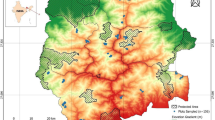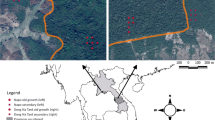Abstract
We studied forest vegetation at Lata–Tolma–Phagti, a protected area and part of Nanda Devi Biosphere Reserve in the western Himalaya. We analyzed community composition, population structure, regeneration patterns, and projected development of future compositional patterns. We sampled ten 10 × 10 m quadrat for tree species in each of 30 forest stands. We sampled shrubs in ten 5 × 5 m quadrat, and herbs in twenty 1 × 1 m quadrat within each forest stand. We recorded 248 plant species from 8 forest communities. Broadly the demographic profiles at study sites exhibited progressive structures suggesting long term persistence of the communities/species. Density–diameter distribution revealed greater proportions of seedlings and a significant decline (P < 0.05) in the proportion of trees in older age/size classes. Of the 23 recorded tree species, 13.0 % showed good, 52.2 % fair, 26.1 % poor and 8.7 % no regeneration. Differences in regeneration by species are indicative of future forest structure and dynamics. Assessment of changes in structure of forest types provides baseline data for development of priorities for conservation of other representative landscapes in the reserve as well as in the Himalaya.





Similar content being viewed by others
References
Adhikari BS, Rikhari HC, Rawat YS, Singh SP (1991) High altitude forests: composition diversity and profile structures in a part of Kumaun Himalaya. Trop Ecol 32:86–97
Ahmad I, Ahmad MSA, Hussain M, Ashraf M, Ashraf MY, Hameed M (2010) Spatiotemporal aspects of plant community structure in open scrub rangelands of submountainous Himalayan plateaus. Pak J Bot 42(5):3431–3440
Aksamit SE, Irving FD (1984) Prescribed burning for lowland black spruce regeneration in Northern Minnesota. Can J For Res 14:107–113
Baduni NP, Sharma CM (2001) Population structure and community analysis on different aspects of Sal savanna forest type in outer Garhwal Himalaya. Indian For 127(9):1001–1011
Bankoti NS, Rawal RS, Samant SS, Pangtey YPS (1992) Forest vegetation of inner hill ranges in Kumaun, Central Himalaya. Trop Ecol 33:41–53
Bhandari BS (2003) Blue pine (Pinus wallichiana) forest stands of Garhwal Himalaya: composition, population structure and diversity. J Trop For Sci 15(1):26–36
Bhuyan P, Khan ML, Tripathi RS (2003) Tree diversity and population structure in undisturbed and human-impacted stands of tropical wet evergreen forest in Arunachal Pradesh, Eastern Himalayas, India. Biodivers Conserv 12(8):1753–1773
Boring LR, Monk CD, Swank WT (1981) Early regeneration of a clear cut southern Appalachian forest. Ecology 62:1244–1253
Cairns DM, Moen J (2004) Herbivory influences tree lines. J Ecol 92:1019–1024
Criddle RS, Church JN, Smith BN, Hansen LD (2003) Fundamental causes of the global patterns of species range and richness. Russ J Plant Physl 50:192–199
Dhar U, Rawal RS, Samant SS (1997) Structural diversity and representativeness of forest vegetation in a protected area of Kumaun Himalaya, India: implications for conservation. Biodivers Conserv 6:1045–1062
Gairola S (2005) Assessment of diversity pattern in sub-alpine forests of west Himalaya: recruitment strategy, litterfall and nutrient return. Ph.D. thesis. India: HNB Garhwal University, Srinagar (Garhwal)
Gairola S, Rawal RS, Todaria NP (2008) Forest vegetation patterns along an altitudinal gradient in sub-alpine zone of west Himalaya, India. Afr J Plant Sci 2:42–48
Garkoti SC (2008) Estimates of biomass and primary productivity in a high-altitude maple forest of the west central Himalaya. Ecol Res 23:41–49
Goff FG, West DC (1975) Canopy-under storey interaction effects on forest population structure. For Sci 21:98–108
Greig-Smith P (1957) Quantitative plant ecology. Academic Press, New York, p 198
Joshi HC (2002) Assessment of habitat diversity, forest vegetation and human dependence in the buffer zone of Nanda Devi Biosphere Reserve of west Himalaya. Ph.D. theis. Nainital India: Kumaun University, p 535
Joshi HC, Samant SS (2004) Assessment of forest vegetation and conservation priorities of communities in part of Nanda Devi Biosphere Reserve, West Himalaya. Part I. Int J Sustain Dev World Ecol 11:326–336
Kershaw KA (1973) Quantitative and dynamic plant ecology, 2nd edn. Edward Arnold Limited, London, p 308
Khan ML, Rai JPN, Tripathi RS (1987) Population structure of some tree species in disturbed and protected sub-tropical forests of north-east India. Acta Oecol-Oec Appl 8(3):247–255
Kharkwal G (2009) Qualitative analysis of tree species in evergreen forests of Kumaun Himalaya, Uttarakhand, India. Afr J Plant Sci 3(3):49–52
Khumbongmayum AD, Khan ML, Tripathi RS (2006) Biodiversity conservation in sacred groves of Manipur, northeast India: population structure and regeneration status of woody species. Biodivers Conserv 15:2439–2456
Korner C (1998) A re-assessment of high elevation treeline positions and their explanation. Oecologia 115:445–459
Lieberman D, Li M (1992) Seedling recruitment patterns in a tropical dry forest in Ghana. J Veg Sci 3:375–382
Lorimer CG, Dahir SE, Nordhiem EV (2001) Tree mortality rates and longetivity in mature and old growth hemlock-hardwood forests. J Ecol 89:960–970
Macdonald IAW, Loope LL, Usher MB, Hamann O (1989) Wildlife conservation and the invasion of nature reserves by introduced species: a global perspective. In: Drake JA, Mooney HA, di Castri F, Groves RH, Kruger FJ, Rejmanek M, Williamson M (eds) Biological invasions: a global perspective. SCOPE, Wiley, pp 281–300
Milchunas DG, Lauenroth WK (1993) Quantitative effects of grazing on vegetation and soils over a global range of environments. Ecol Monogr 63:327–366
Mishra BP, Tripathi RS, Tripathi OP, Pandey HN (2003) Effects of disturbance on the regeneration of four dominant and economically important woody species in a broad-leaved subtropical humid forest of Meghalaya, north east India. Curr Sci 84(11):1449–1453
Mishra BP, Tripathi OP, Tripathi RS, Pandey HN (2004) Effect of anthropogenic disturbance on plant diversity and community structure of a sacred grove in Meghalaya, northeast India. Biodivers Conserv 13:421–436
Misra R (1968) Ecological work book. Oxford & IBH Publishing Company, Calcutta, p 242
Muller-Dombois D, Ellenberg H (1974) Aims and methods of vegetation ecology. Wiley, New York, p 547
Negi SS (1995) Uttarakhand: land and people. MD Publications Pvt Ltd, Delhi, p 149
Oliver CD, Larson BC (1990) Forest Stand dynamics. Government document. McGraw Hill, Inc, New York, p 467
Perira JS, Kozlwski TT (1977) Water relations and drought resistance or young Pinus banksiana and Pinus resinosa plantation trees. Can J For Res 7:132–137
Rao PB (1988) Effects or environmental factors on germination and seedling growth in Quercus floribunda and Cupressus torulosa, tree species of central Himalaya. Ann Bot 61:531–540
Rawal RS, Pangtey YPS (1994) Distribution and structural-functional attributes of trees in the high altitude zone of central Himalaya, India. Vegetatio 112:29–34
Rawat B (2013) Changes in vegetation diversity and plant responses in Nanda Devi Biosphere Reserve over the last two decades. Ph.D. thesis. Kumaun University, Nainital, Uttarakhand, India, p 179
Saxena AK, Singh JS (1984) Tree population structure of certain Himalayan forests and implications concerning the future composition. Vegetatio 58:61–69
Saxena AK, Singh SP, Singh JS (1984) Population structure of forests of Kumaun Himalaya: implications for management. J Environ Manag 19:307–324
Schulte PJ, Marshall PE (1983) Growth and water relations of black locust and Pine seedlings exposed to controlled water-stress. Can J For Res 13:334–338
Shankar U (2001) A case study of high tree diversity in a sa1 (Shorea robusta)—dominated lowland forest of Eastern Himalaya: floristic composition, regeneration and conservation. Curr Sci 81:776–786
Shannon CZ, Weiner W (1963) The mathematical theory of communications. University of Illinois Press, Urbane
Shrestha BB, Ghimire B, Lekhak HD, Jha PK (2007) Regeneration of treeline Birch (Betual utilis D. Don) forest in a trans-Himalayan dry valley in central Nepal. Mt Res Dev 27:259–267
Singh JS, Singh SP (1992) Forests of the Himalaya. Structure, functioning and impact of man, Nainital, India: Gyanodaya Prakashan. Fine Art Press, Delhi, p 295
Singh SP, Adhikari BS, Garkoti SC, Rawat YS (1996) Structural and functional characteristics of the forest ecosystems around Nanda Devi Biosphere Reserve. In: Ramakrishnan PS, Purohit AN, Saxena KG, Rao KS, Maikhuri RK (eds) Conservation and management of biological resources in Himalaya. Oxford & IBH Publishing Co. Ltd, New Delhi, pp 413–432
Singh SP, Rawat YS, Garkoti SC (1997) Failure of brown oak (Quercus semecarpifolia) to regenerate in central Himalaya: a case of environmental semisurprise. Curr Sci 73:371–374
Spurr SH, Barnes BV (1980) Forest ecology. Wiley, New York, p 687
Swaine MD, Lieberman D, Hall JB (1990) Structure and dynamics in a tropical dry forest in Ghana. Vegetatio 88:31–51
Todaria NP, Pokhriyal P, Uniyal P, Chauhan DS (2010) Regeneration status of tree species in forest of Phakot and Pathri Rao watersheds in Garhwal Himalaya. Curr Sci 98(2):171–175
West DC, Shugart HH Jr, Ranny JW (1981) Population structure of forest over a large area. Forest Sci 27:701–710
Acknowledgments
Authors are grateful to the Director of the Institute for providing the necessary facilities to carry out this work. We are thankful to In-House Project-08 (2007–2012) for providing the financial facilities throughout the study period. Sincere thanks goes to DST SB/YS/LS-205/2013 and CSIR (09/560 (0015)/2011-EMRI), Govt. of India for the financial support. We also thank the local inhabitants for their generous help during extensive field visits.
Author information
Authors and Affiliations
Corresponding author
Additional information
Project funding: This study was supported by DST SB/YS/LS-205/2013 and CSIR (09/560 (0015)/2011-EMRI), Govt. of India.
The online version is available at http://www.springerlink.com
Corresponding editor: Zhu Hong
Rights and permissions
About this article
Cite this article
Rawat, B., Gairola, S., Chandra Sekar, K. et al. The present status and future prospects of forest vegetation in part of Nanda Devi Biosphere Reserve (a World Heritage Site), India. J. For. Res. 26, 897–904 (2015). https://doi.org/10.1007/s11676-015-0109-x
Received:
Accepted:
Published:
Issue Date:
DOI: https://doi.org/10.1007/s11676-015-0109-x




